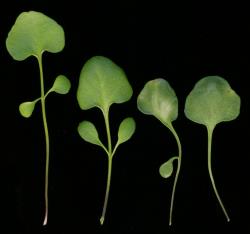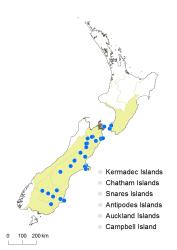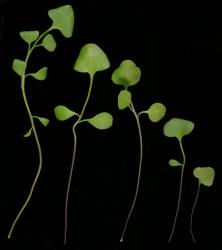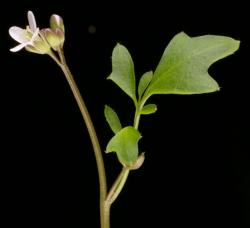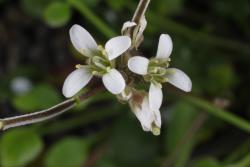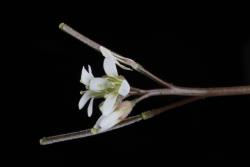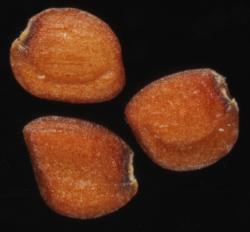Perennial herb, single rosette or with short lateral branches, stem and branches 0.5–1.2 mm diam. Leaves up to 125 mm long, pinnatisect; lamina 30.0–65.0(–90) × 8.0–50.0 mm, light green to pale grey-green, membranous, glabrous or sparsely to moderately hairy on adaxial and abaxial surfaces, margin and petiole sparsely to moderately hairy, hairs up to 0.4 mm long. Terminal pinna 4.5–25.0 × 5.0–25.0(–30.0) mm, reniform, reniform-deltoid to reniform-rhomboid, margin usually with 1–5 shallow lobes and 1–5 small conspicuous hydathodes, apex obtuse with a small conspicuous hydathode, base cordate to truncate. Lateral pinnae 2–4(–6), 3.0–13.0 × 3.0–15.0, reniform, reniform-deltoid to orbicular-rhomboid, petiolule 2.0–16.0 mm long, glabrous; petiole up to 50 mm long. Cauline leaves similar to rosette leaves but usually smaller, lateral pinnae absent or 2(–4); pinnae reniform, orbicular-reniform to elliptic, lobes shallowly rounded to narrowly triangular, hydathodes conspicuous. Inflorescence racemose, often with lateral racemes, each raceme 5–8-flowered; peduncle up to 350 mm long, 0.5–1.2 mm diam. at base, spreading to ascending, sparsely to moderately hairy, glabrescent, hairs retrorse, sometimes glabrous in lower parts. Pedicels 4.0–25.0(–35.0) mm long, 0.3–0.5 mm diam., terete, sparsely to densely hairy, hairs retrorse. Sepals 1.7–1.9 × 0.6–0.9 mm, elliptic-oblong, saccate, green or red-brown; sparsely hairy distally, hairs up to 0.2 mm long, retrorse to spreading, margin white and membranous; apex obtuse, base truncate. Petals 4.0–4.5 × 1.1–1.3 mm, white, limb oblong to oblong-obovate; apex obtuse; base attenuate, tapering to a 0.7–1.0 mm-long claw. Stamens 6; median filaments 4, 2.6–2.7 mm long; lateral filaments 2, 2.2–2.3 mm long; anthers 0.3–0.4 mm long, cream to pale yellow, when dehiscent held at a similar height to or slightly below the stigma. Ovary 2.0–2.1 mm long, 0.5–0.6 mm diam., ± terete, green to green-brown, valves with short retrorse hairs up to 0.1 mm long; ovules 26–30; style 0.6–0.7 mm long, ± terete; stigma 0.4–0.6 mm diam. Siliques 9.0–26.0 × 1.0–1.4 mm, valves green-brown to red-brown at maturity, straw-coloured when dehiscent, style 0.3–1.7 mm long, replum 0.4–0.5 mm wide; valves and usually replum sparsely to densely hairy, hairs 0.1–0.2 mm long, appressed to spreading, retrorse. Seeds 1.0–1.2 mm long, 0.7–0.9 mm wide, 0.2–0.3 mm thick, oblong, broadly oblong to oblong-orbicular, yellow-brown to henna; wing absent.
Cardamine intonsa is distinguished from C. glara by the leaves having conspicuous hydathodes, smaller sepals, petals and filaments, and the silique usually being moderately to densely covered in short, appressed to spreading and retrorse hairs.
North Island: Southern North Island.
South Island: Sounds Nelson, Marlborough, Westland, Canterbury, Otago, Southland.
Cardamine intonsa primarily occurs on rock bluffs and outcrops in open sites and forest, and also on scree, river terraces, at the margin of water courses, and among tussocks/herbfield.
Cardamine intonsa is assessed as having a conservation status of Not Threatened (de Lange et al. 2018).
Flowering August–January; Fruiting November–February.
The hairs on the ovary and silique valves of this species can be variable in placement (Heenan 2017). The hairs usually evenly cover the length of the valve, but in several collections from Coopers Knob, Port Hills, Canterbury, the valves are either completely hairy (e.g., CHR 620183, CHR 497758) or only partially hairy at the distal and proximal ends (e.g., CHR630005, CHR 630006). The replum is usually sparsely to moderately hairy (e.g., CHR 607869, CHR 226068), but can sometimes be glabrous (e.g., CHR 363591, WELTU 7447).



